Classic Sukiyaki, The Quintessential Japanese Beef Hot Pot
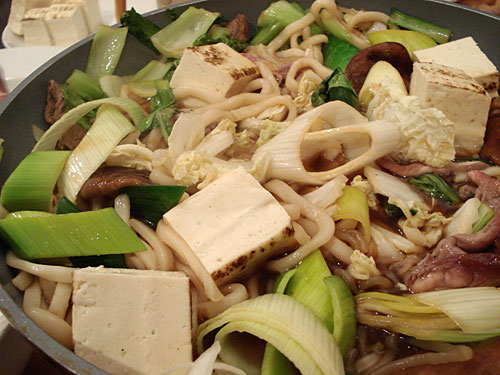
Sukiyaki (すき焼き)is a Japanese word that is widely known outside of Japan, but very few people have actually had the real thing unless they've been invited to a Japanese person's home for dinner - or gone to a traditional inn or ryoutei (high end traditional Japanese restaurant) where it is cooked for you at the table. This is because, like tori nabe, this is really another nabe that is cooked at the table, at home, rather than eaten at a restaurant. You may encounter 'sukiyaki' on some restaurant menus, but if it's been cooked in advance in the kitchen, it really isn't sukiyaki. (I'm not sure why there are dedicated shabu-shabu restaurants but no sukiyaki restaurants, but I think it's because sukiyaki is so strongly associated with home cooking.)
Unlike tori nabe, sukiyaki is not inexpensive, since you need top grade steak-quality meat. If you have access to a Japanese grocery store or a butcher that is familiar with the 'sukiyaki' cut, you can buy ready-cut meat there. (In New York, I used to get sukiyaki meat from Schaller and Weber on the Upper East Side). If you can't get sukiyaki meat, get a piece of sirloin with a good amount of marbling and a thick piece of fat attached. Allow for about 100 grams / 3 1/2 ounces of meat per person. You do not need to use wagyuu or Kobe beef - that would be overkill. In Japan, sukiyaki is the quintessential gochisou (御馳走) - feast or treat, because good beef is the most expensive kind of meat. It's what you have for a special occasion, or just after payday.
Sukiyaki can be enjoyed at any time of the year, but any kind of nabe seems to be best suited to the winter, when the family can gather around the dining table helping themselves from a fragant, steaming pan of food.
There are two basic methods of making sukiyaki: Kanto, or Tokyo-area style, and Kansai, or Kyoto/Osaka area style. Since I'm from the Tokyo area I'll show you how to do the Tokyo style, with a recipe for the Kyoto method below.
Recipe: Classic Kanto Style Sukiyaki
Feeds 4 adults
- 1 lb / 450g well marbled sirloin or similar, with a chunk of fat on the outside; OR about 1 lb of sukiyaki beef with a small chunk of beef fat
- 1 block of firm tofu or yakidofu (firm tofu that has been lightly grilled on the outside, available at Japanese grocery stores), cut into chunks (allow for 2 chunks per person)
- 1 small or 1/2 large chinese/napa cabbage, cut up into chunks
- a bunch of green leafy vegetables - I used pak choy here (traditional green is shungiku; use what you have)
- 4 large or 8 small/medium raw shiitake mushrooms, stems cut off (you can use portobello mushrooms instead, sliced - 1-2 big ones)
- The white of 1 leek, sliced
- 2-3 packs of fresh or frozen udon noodles
- 1 pack of rinsed and blanched shirataki noodles
For the sauce, called warishita (割り下)
- 1 1/2 cups water
- 1/2 cup dark soy sauce
- 1/4 cup sake
- 1/4 cup mirin
- 1/4 cup sugar
Optional:
- 4 raw eggs, to serve as the dipping sauce
Equipment:
- A tabletop burner (see the tori nabe article)
- A sukiyaki pot (a flat cast iron pot), or a large sauté pan or frying pan with fairly high sides so that you can pile in the vegetables and so on
- Long chopsticks or a long fork or tongs
- Smallish bowls for serving, one per person. Breakfast cereal sized bowls are good.
If you got the hunk of steak meat, put it in the freezer until it's half-frozen and stiff. This makes it easier to slice. Cut the outer fat off and reserve. Slice the rest against the grain into thin slices. Arrange neatly on a plate.
Cut up the vegetables and put into bowls, ready to go. Take the udon noodles out of their packets Rinse and briefly blanch the shirataki noodles. (The amount of udon noodles depends on whether you will be having rice with the meal or not. If yes, then you only need 1 or 2 packs of udon; if not, then go for more udon.)
Mix all the liquid ingredients for the warishita together and put into a jug or something. Have the sugar ready. (Note: my stepfather just pours each ingredient directly into the pot, but pre-measuring things will probably be easier for beginners)
Set out the burner, the pan, the bowls and utensils We're ready to go now!
Heat up the pan on the burner, with the reserved piece or pieces of beef fat. Rub the fat around the pan a bit until it's melting.
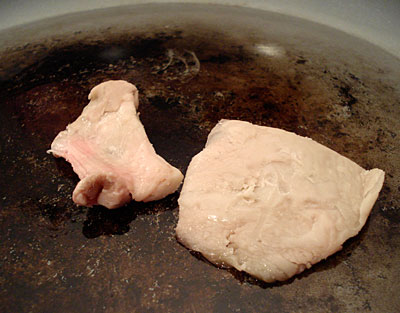
Once there's a good film of melted fat all around the pan, pour in the sugar and mix around a bit. Then add the liquid ingredients. If the pan is hot enough it should boil up almost immediately.

Let it simmer for a bit to evaporate the alcohol in the sake and mirin. Then, add around a quarter or so of the beef slices. (Take out the beef fat pieces at this time.)
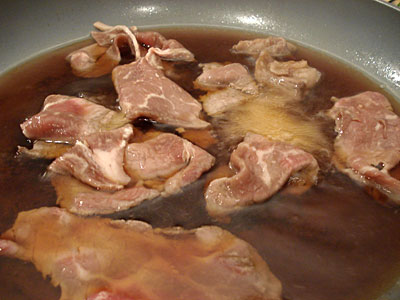
These first beef slices plus the beef fat provide the base flavor for sukiyaki, together with the warishita ingredients. Once the beef is cooking, you can start adding the other ingredients. Start with the vegetables and shiitake mushrooms, then add the tofu and shirataki. Remember to scoop out the beef slices and eat them!
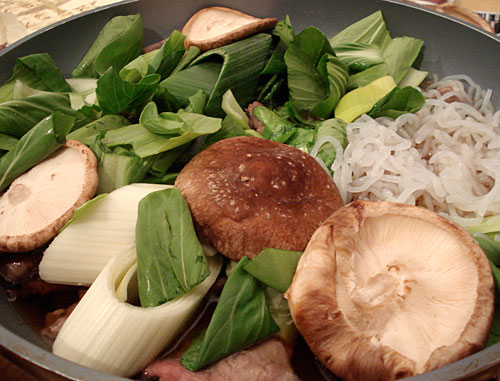
Keep eating the vegetables and things as they cook. About halfway through, add the udon (if you add it earlier it can get a bit overcooked, though it will still be very tasty). Now, this is optional, but the standard dipping sauce for sukiyaki is a raw beaten egg. But only do this if you are sure of the quality of your eggs - they should be farm fresh, maybe date-stamped, or pasteurized.
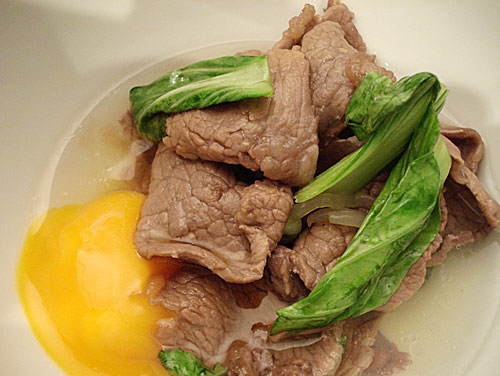
Keep on taking out cooked stuff and putting more stuff in to cook. If the pan gets too dry, just add a bit of water and maybe a bit more soy sauce. Near the end of the proceedings, this is how the pan looks - everything a mellow light brown, having slurped up the goodness of that sauce.
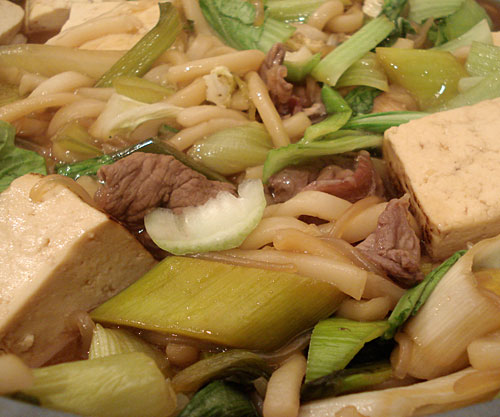
Leftover sukiyaki, mixed with some egg and cooked, is delicious over hot rice. (You could also simmer it in a pan until the liquid is almost evaporated and use it in a bento the next day.)
Variant: Kansai Style Sukiyaki
With Kansai style, you pan fry all the meat before adding everything else. Melt the beef fat in the pan as per the Kanto style, then add the meat slices. Add the sugar to the pan and let it coat the meat. Then add the warishita, and proceed as for the Kanto style. I prefer the Kanto style because I think the meat can get a bit tough with Kansai style - and besides, that's the method I grew up with. In Kansai style, you often add fu to the pan (reconstitute the fu in water first, squeeze out well, and add to the sukiyaki pot).
Extra: The Sukiyaki Song, which has nothing to do with sukiyaki
In 1963, a Japanese song named The Sukiyaki Song became a no. 1 hit in the U.S., even though it was sung in Japanese by a singer unknown to the west, called Kyu Sakamoto (坂本九). It was called Sukiyaki because some record executive decided that that word sounded appropriately Japanese to an American audience. As the Wikipedia entry says, the original lyrics have nothing to do with sukiyaki - it's actually a rather sad song about someone walking alone at night with a broken heart. And the original title is 上を向いて歩こう (Ue o muite arukou) - Let's Walk Looking Upwards. Here are the original lyrics, with my translation:
上を向いて 歩こうよ Let's walk looking upwards
涙がこぼれないように So that (my) tears don't fall
思い出す 春の日 (I) remember that spring day (with you)
一人ぽっちの夜 A lonely night
上を向いて歩こう Let's walk looking upwards
にじんだ 星をかぞえて Counting the blurry stars in the sky
思い出す 夏の日 (I) remember the summer day (with you)
一人ぽっちの夜 A lonely night
幸せは 雲の上に Happiness is above the clouds
幸せは 空の上に Happiness is above the sky
上を向いて 歩こうよ Let's walk looking upwards
涙がこぼれないように So that (my) tears don't fall
泣きながら 歩く (I) walk while crying
一人ぽっちの夜 A lonely night
思い出す秋の日 (I) remember that autumn day (with you)
一人ぽっちの夜 A lonely night
悲しみは 星のかげに Sadness is in the shadows of the stars
悲しみは 月のかげに Sadness is in the shadow of the moon
上を向いて 歩こうよ Let's walk looking upwards
涙がこぼれないように So that (my) tears don't fall
泣きながら 歩く (I) walk while crying
一人ぽっちの夜 A lonely night
一人ぽっちの夜 A lonely night (I am alone tonight)
Here is the original singer, Kyu Sakamoto, singing Ue o muite arukou when he was 22 years old in 1963:
Kyu Sakamoto, known affectionately as Kyu-chan, was very popular throughout his lifetime in Japan as an all around entertainer. I was too young to know him during his singing heyday in the '60s, and when I did become cognizant of him I rather disliked him because he was known as a do-gooder and self-promoter (he did a lot of charity work and such, much of it well publicized, which was not really that common for Japanese celebrities). Besides, his singing was considered awfully old fashioned by us kids.
He died tragically in the Japan Airlines Flight 123 crash at the age of 44. Since then, I've come to appreciate his unique singing style as well as his persona a lot more. His best songs were those with upbeat music and rather sad or wistful lyrics. Here's another one of his big hits in Japan, 見上げてごらん 夜の星を (Miagete goran yoru no hoshi o : Look Up At The Stars In the Sky):
I think he was so popular, especially in the 1960s, because the combination of youthful bravado and cheerfulness tinged with a sadness, even tragedy that he was able to convey, perfectly fit the mood of the times, when Japan was growing as a nation at an alarming pace while experiencing the side effects of such growth such as environmental disasters, stress and alienation. I'm not sure if he'd still be a hit in today's more cynical Japan though.
If you enjoyed this article, please consider becoming my patron via Patreon. ^_^

 Welcome to Just Hungry, where we serve authentic Japanese recipes and more! I'm
Welcome to Just Hungry, where we serve authentic Japanese recipes and more! I'm 













Comments
yoko
13 January, 2009 - 21:36
Permalink
Re: Classic Sukiyaki
Sukiyaki has become my mom's traditional meal for New Year's, in addition to osechi. She makes it Kanto style, except without coating the pan with fat (she uses vegetable oil, presumably for health reasons), and with only shirataki noodles.
They get their meat from Mitsuwa, which for them is a 2+ hour drive. But good meat makes all the difference.
I need a proper tabletop cooker to try making nabe (my mom actually uses an electric skillet), but boy, it's the perfect thing to have right now!
karaimame
13 January, 2009 - 22:52
Permalink
Re: Classic Sukiyaki, The Quintessential Japanese Beef Hot ...
Sukiyaki is so good. I´ve made my mother send me an electric pan just because I was so needing to make sukiyaki too but couldn´t find a perfect combination "pan-frying pan-tabletop cooker".
A pitty I don´t make it so often , once beef can be very expensive here :(.
Oh and it was lovely you mentioned Ue o muite arukou song.. I always believed Sakamoto being the "young melancholic-almost grunge :)" guy of that time . I like the song a lot (tnx to dad..) , but I don´t really appreciate that it is known as "Sukiyaki song" all around the world.. oh well..
Elizabeth
14 January, 2009 - 01:18
Permalink
Re: Classic Sukiyaki, The Quintessential Japanese Beef Hot ...
OMG ever since my grandmother went back to Japan, I've been missing her sukiyaki so much! Especially with it being winter and all...
Thank you thank you thank you! This is the answer to my prayers! (I would still want to know her recipe, though, it can't be much different from the varieties shown here)
Karla
14 January, 2009 - 01:22
Permalink
Re: Sukiyaki
Maki, I have such wonderful memories of when I was growing up here in Los Angeles in the 1960's. Yup. My Dad used to go to the local little Japanese market. We had a large Japanese-American population here. Even more-so now. It's fantastic! Anyway, Sukiyaki was such an amazing treat for us as well as learning how to cook at a little table-top burner. But when I learned about the addition of shungiku I was thrilled! To me that is still a MUST in most of my Nabes. I also especially remember the amazing flavor of the cooked beef being dipped into the raw egg. Mitsuwa has great Sukiyaki beef. Also, you have to use the beef fat when first cooking. Kyu Sakamoto's "Sukiyaki Song" was always a favorite of mine. Maybe because in the early 60's he represented the Japanese spirit to us here. I was in Japan when his plane went down. It was a true loss for those who I was working with. They were very sentimental about it. I'm not sure that the music that I still love from the 60's or 70's would be a hit with today's' youth either, but I'm getting out my Sukiyaki-Nabe, cracking open a bottle of good sake, and raising a toast to Kyu Sakamoto. Thank you Maki!
Shokunin.
14 January, 2009 - 07:27
Permalink
Re: Classic Sukiyaki, The Quintessential Japanese Beef Hot ...
This was my Dad's favorite party dish and I haven't had it since he passed several years ago. Have to bring out the cast iron pan to make some later this week. We used to make it on a keawe hibachi, indoors but since that's not PC anymore, I guess I'll use my portable propane stove. We used to call a hibachi hichirin then. Anyone know if there's a difference?
I have to look this up but I believe that the song is dedicated to a female actress who also died young. The reference to looking to the sky to hide the tears is due to mourning this actress.
maki
14 January, 2009 - 10:00
Permalink
hibachi and shichirin
I guess that hichirin = shichirin (七輪)? A hibachi is one kind of charcoal heater/cooking heat source, and a shichirin is another, so I am guessing that your propane stove was called a hibachi (s)hichirin to convey the idea that it was a replacement for both? Just guessing here!
Eric Hill
14 January, 2009 - 17:58
Permalink
Re: Classic Sukiyaki, The Quintessential Japanese Beef Hot ...
I was just back in Japan over the new year and of course one of top dishes on my list that had to be eaten was sukiyaki(not kanto style though). I live in Michigan near Detroit so getting the thinly sliced high quality beef is just not possible around here. The few Japanese grocers only sell frozen thinly sliced beef and that is just not acceptable.
I actually never knew about the kanto style method of making sukiyaki until about a week and a half ago when I was watching a "food around Japan" program. Interestingly though they talked about making sukiyaki with miso(as opposed to soy sauce) in Yokohama as, according to the program, that is how it was first eaten. The people who tasted it raved about how delicious it was (of course that is what they always do) but to me it didn't look too appetizing. I was wondering if you had ever heard of this or if you have ever eaten it?
-Eric
Sylvia S.
14 January, 2009 - 18:58
Permalink
Re: Classic Sukiyaki, The Quintessential Japanese Beef Hot ...
SBS
In the '60's when I was in my own early 20's in northern California, almost everyone had a little hibachi, bought at Cost Plus and used outside on a deck or porch -- or taken to the beach. Heavy cast iron with wooden handles and a cooking grate that folded. Used charcoal briquets and was practically indestructible. Now it would be a small Weber "Smoky Joe" grill -- or a larger one.
The only time I had sukiyaki was at the lovely and so exotic Sakura Gardens in Mountain View (now closed), cooked at the table by a waiter or waitress. You could sit at a regular table or on the floor in another room. It was expensive and so a special treat to go there. Your entry today brought back a flood of good memories -- including the song. Thank you very much, Maki.
Elise
15 January, 2009 - 00:06
Permalink
Love sukiyaki!
Oh Maki,
I love sukiyaki! Use to make it in Kyoto with a bunch of Aikido club members over for dinner. Love the social aspect of this dish and several others in Japanese cuisine. Thanks for the YouTube videos. I do recognize the first song, like a blast from the past. I was born in 61 so would have still heard that song around when I was a kid.
maki
15 January, 2009 - 20:29
Permalink
Re: Love sukiyaki!
Apparently, the 'Sukiyaki song' is considered so much of its time that it was used in a recent episode of Mad Men! I haven't seen season 2 yet but am looking forward to seeing that episode. I'm glad it and the dish brought back good memories for you :)
Izumi
16 January, 2009 - 12:06
Permalink
Re: Classic Sukiyaki, The Quintessential Japanese Beef Hot ...
Yum, it looks delicious! I actually haven't eaten sukiyaki at all before, though it's so highly recommended. Would a regular nabe pot work OK for this?
maki
16 January, 2009 - 17:48
Permalink
Re: Classic Sukiyaki, The Quintessential Japanese Beef Hot ...
I'm not too sure what a regular nabe pot is. Do you mean a donabe (a ceramic pot)? If so, that wouldn't be too good for sukiyaki, since that kind of pot is meant for simmered food. A skillet or something with a wide,flat bottom would be better.
Pat
16 January, 2009 - 21:18
Permalink
donabe ceramic pot
I've been wanting to ask about the donabe pot. Can it be used on a tabletop gas cooker for nabe? Or is it for hotpot that you cook on regular stove and then pour into it? Since you said it's meant for simmered food, it sounds like I cannot use it on tabletop cooker.
maki
16 January, 2009 - 22:35
Permalink
Re: donabe ceramic pot
You can use a donabe for things like the torinabe; it's also good for nabe that is cooked on the stove but kept warm on the table - e.g. for oden. Sukiyaki is really meant to cook quite fast though, so that's why you need a wide-bottom shallow pot or pan.
Izumi
17 January, 2009 - 16:12
Permalink
Re: donabe ceramic pot
I did mean a donabe, yes. :) I'll see if I can find a skillet alternative then, thanks!
BarbJ
16 January, 2009 - 22:48
Permalink
Re: Classic Sukiyaki, The Quintessential Japanese Beef Hot ...
I'm so glad you posted this as it clears up a mystery for me. I've heard of Sukiyaki growing up in California for years, but never had it until a few months ago at a usually very good sushi restaurant. It was on the menu and I figured I'd try it.
Well it was just awful. They did not make it at the table, but I didn't know they were supposed to. It came in a wide pot and was mostly a lot of very, very sweet broth with some overcooked dry thin beef and soggy noodle. A few veggies swam in the broth too, but were also soggy and overcooked. I usually love all kinds of Japanese food, but just couldn't stomach this. Now I see it was not good sukiyaki, and looked nothing like your delicious looking pictures.
I may try to make this at home someday. I guess it's just not a dish well suited to restaurant cooking.
maki
17 January, 2009 - 11:42
Permalink
Re: Classic Sukiyaki, The Quintessential Japanese Beef Hot ...
Indeed, sukiyaki is good because it's cooked at the table and you can scoop out the food as soon as it's cooked right. The delicate meat can get overcooked very easily!
Sylvia
24 January, 2009 - 17:50
Permalink
Re: Classic Sukiyaki, The Quintessential Japanese Beef Hot ...
There is a teppenyaki restaurant near us and I noticed they had sukiyaki on the menu so we decided to try it last night. It was great - and only a little bit different from what you've described here. They pre-made the "sauce" and brought a big jug of it. Then they put fat in the hotpot and put onions in to fry before adding the sauce and then two slices of beef - so the beef was boiled but never fried. We had a plate with a few more slices of meat and a platter filled with vegetables. The waitress recommended we put the mushrooms in first and left us to it.
We had a jug of water to top up the liquid but to be honest the pot was half full from the sauce - a lot more than it seemed like you describe here - and it was clearly not going to need more.
We were wondering about the chopsticks though - is it ok to use your own chopsticks for this dish even though it's a communal pot?
maki
24 January, 2009 - 19:35
Permalink
Re: Classic Sukiyaki, The Quintessential Japanese Beef Hot ...
If you aren't provided with communal serving utensils, it's fine to just use your chopsticks. (Sukiyaki is a family-style informal meal anyway.)
Adrian
9 January, 2010 - 18:22
Permalink
Re: Classic Sukiyaki, The Quintessential Japanese Beef Hot ...
What type of dark soy sauce do you use? From what I know, there are 3 types of dark soy sauces, namely koikuchi, tamari and saishikomi.
I normally have this at the restaurants and decided to give it a go at home. Unfortunately, I used light soy sauce and it ended up being overly salty. That's kind of how I stumbled upon this recipe as I was trying to figure out if I should use less light soy or just switch to dark soy.
maki
9 January, 2010 - 21:13
Permalink
Re: Classic Sukiyaki, The Quintessential Japanese Beef Hot ...
We use regular koikuchi soy sauce. Usukuchi or light soy sauce is actually saltier than dark.
Lori
18 February, 2011 - 01:49
Permalink
Re: Classic Sukiyaki, The Quintessential Japanese Beef Hot ...
I had a horrible restaurant experience with sukiyaki years ago. Now I know why. :) I made this tonight in my cheap rice cooker and it was delicious! I just kept it on "cook" with the lid off and it simmered perfectly.
Dryflour
22 March, 2011 - 17:12
Permalink
Re: Classic Sukiyaki, The Quintessential Japanese Beef Hot ...
All of your posts are so inspiring. You are clearly passionate and dedicated to your work and hobbies. I love how much cultural anecdote you pack each of your posts with. You must spend hours on each post! I especially appreciate all of your vegan posts (so why am I commenting on this particular post about beef? because of your interesting anthropological tidbits like shabu-shabu that keep me opening up wikipedia to learn more!) thanks a million, you are very talented! best of luck to you, Dryflour
Eoin MagRaighne
8 May, 2011 - 18:13
Permalink
Kyu Sakamoto ...
How well I remember local dj Boom-Boom Brannigan going nuts
[in a good way] over KS. KS did have another excellent song in 1963, which didn't do as well as 'Sukiyaki', but which I
preferred to the latter: 'Shina no Yoru' [China Nights]. It
was a revival of a song from the 1930's &, in the 1963 version, was in both Japanese and English.
PS. For some reason, which I can't really explain, the other
Japanese music I like is- Gagaku. It has a hypnotic affect
on me. Very much as good bagpipe music does. A cross-cultural
oddity, eh?
maki
9 May, 2011 - 09:09
Permalink
Re: Kyu Sakamoto ...
The sound of sho (the strange looking wind instrument usually used in gagaku) does sound a bit like a very weak bagpipe ^_^
silvis
21 January, 2012 - 19:59
Permalink
Re: Classic Sukiyaki, The Quintessential Japanese Beef Hot ...
Love sukiyaki! Will give this a try once I get all the ingredients!
Regarding sake, since there's a lot of sake out there I was wondering which sort is best to cook sukiyaki with? Dry sake? Getting so confused with the variety available on japancentre.com
maki
22 January, 2012 - 09:06
Permalink
Re: Classic Sukiyaki, The Quintessential Japanese Beef Hot ...
Dry sake is fine for cooking. No need to get anything expensive either. Just be aware that 'cooking sake' does contain salt, so you need to adjust recipes for that.